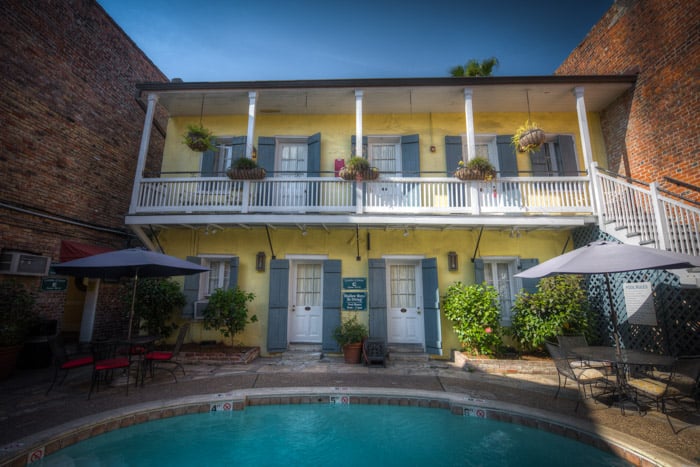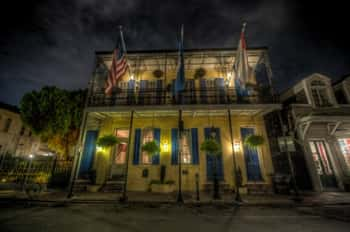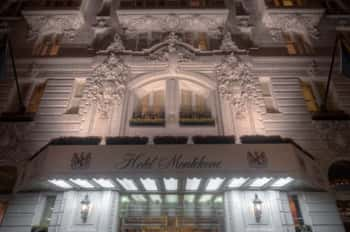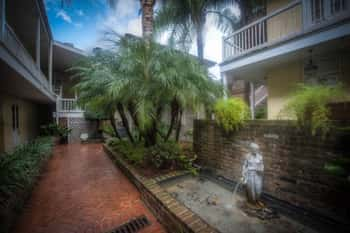We've partnered with the Hotel St. Pierre to bring you a Room + Ghost Tour Package in New Orleans. For more information, please visit their website.
Nestled in the back of the French Quarter, just two blocks from Bourbon, Hotel St Pierre stands at the corner of Burgundy and Dumaine Streets as a uniquely blended French Colonial architectural building with a modern flare.
Away from the bustling commercial riverside of the French Quarter (i.e. anything between N. Rampart and Bourbon Streets), this corner of the historic Vieux Carre is a tranquil slice of heaven with the good fortune to be excellently located. Twelve buildings, seventy-one guestrooms, and six courtyards ensure that this historic hotel is more comparable to a luxurious mini-estate than a cookie-cutter place to stay while on vacation. (Did I mention the pools and fountains?)
Ranked by the New York Times’ Travel Section as one of the Best Places to Stay in New Orleans, Hotel St Pierre and its surrounding property is one of the oldest in the entire city.
But it goes without saying: with history and longevity comes the ghosts of those who have remained on This Side. Who, though, is haunting this historical landmark?
It was early on in the French Colonization period, around the mid-eighteenth century when Marie Jean Gabriel Peyroux de Roche Molive immigrated to New Orleans, Louisiana.
Although New Orleans was founded in 1718, many families purchased land winding up along the Mississippi River all the way to Baton Rouge. The better the land meant the chance for more revenue and, thus, more personal wealth. Gabriel Peyroux, who was born in France, was not unlike the other fresh-faced French Colonists in the region.
Peyroux married Marie Susana Caue, a native New Orleanian, and they promptly moved out to St. James’ Parish along River Road, where Peyroux practiced as an apothecarist or “druggest." They built a respectable sized home on one side of the river and had a few children.

On 2 January 1772, Peyroux struck gold in the form of free land. Problem was? Gabriel Peyroux had no idea that any land had been bequeathed to him at all.
A year passed . . . nothing.
Two years passed . . . still nothing.
It just so happens that during this period when Peyroux had no clue that luck had sidled up next to him, the land was then promised to Miguel Chiason and Francisco Antailla. And unlike Peyroux, the two men were beyond excited to get their new land primed for money-making ventures.
They surveyed the land, constructed levees, created the road along the riverfront, paid the tithe to the church and other fees. But as much luck as Peyroux had, Chiason and Antailla had none.
Only after the two men had finally completed and finished readying the plot of land did Peyroux finally realize that he had, in fact, been ceded the property some years before. He petitioned the government to recall the land and won in court. After all, Chiason and Antailla had spent the entirety of their fortunes preparing the land that they were left with nothing to fight Peyroux’s petition. They were summarily booted off the property, though Peyroux agreed to pay them the sum that they had already invested in the land.
(I like to imagine that Peyroux was just a nice guy like that).
In 1777, five full years after the land along the Mississippi River was gifted to him, Peyroux, Susana and some of their children moved onto the property.
Only a few years after their move to the Peyroux habitation (French word for ‘plantation’ or ‘family property’), Gabriel commissioned a new house to be built in 1781. It was typical French Creole fare, constructed in the briquette-entre-poteaux architectural style.
(Briquette-entre-poteaux translates to “small bricks between posts.” The bricks were made of Mississippi River mud, Spanish moss and horse hair. This architectural style was most common in Louisiana during the eighteenth century, although very few examples of it still survive today in the French Quarter. Hotel St Pierre and Jean Lafitte’s Blacksmith Shop are probably the best two to see!)
Gabriel Peyroux, it seems, was the sort of French gentleman who made new decisions in a moments’ notice because the house was not even fully completed before he had builder Maurice Milon dismantle the structure . . .
. . . And rebuild it where it stands today at 911 Burgundy Street.
The Peyrouxes chose the corner of Burgundy and Dumaine Streets specifically because Susana’s father, Francois Caue, owned the entire block and had owned it since 1754.
(Nothing like living with the in-laws, am I right?)
Thankfully, this move would be Gabriel Peyroux’s last. Though he was noted as an “apothecary” living at the property in the Census of 1791, Gabriel drew his last breath in 1794 when he passed away. He was one of the first licensed pharmacists in the colony, as he had been approved by the King of Spain to operate his business after Louisiana was sold to King Charles III of Spain in 1762.
Susana Peyroux continued to live in this house, which was one of the very few to escape the Great Fires of 1788 and 1794, until her death in 1838, and it seems that some of the Peyroux offspring stuck close by as well. One of the daughters, Mrs. Lenoix, lived in the three identical “sister townhouses” just a few blocks over from the Peyroux House. And Sylvain Peyroux, one of the sons, became a wine merchant in New Orleans who built Three Oaks Plantation in 1830 a little outside of New Orleans. He was so rich that ten separate properties in the French Quarter were attributed to him as having ownership at one point in time.
The Peyroux Family, for all their moving about, remained one of New Orleans’ earliest prosperous families.
Between 1916 and 1950, the property where the historic Hotel St Pierre stands today had a brief stint as a department store by the name of D.H. Holmes, Ltd. It was during this period that many of the other cottages on the property were brought in for use.
But it was not until 1961 that 1017 Dumaine Street (shares same plot as 911 Burgundy) came to fame as the first ever jazz museum in the entire world. All sorts of memorabilia were collected as part of its permanent exhibit, including the trumpet of Louis Armstrong and the first records of Kid Ory, Jelly Roll Martin and Cozy Cole.
In 1965, the great Jazz musician Louis Armstrong stayed here at the hotel himself, and even Southern writer Tennessee Williams was known to frequent the property, as well.
Today the Jazz Museum is actually housed within the Louisiana State Museum, but many of the priceless artifacts and collectibles are still displayed in the lobby area of the Hotel St Pierre. (Don’t forget to check it out when you book your stay!)
Since its conversion into a hotel in the twentieth century, Hotel St Pierre has remained one of New Orleans’ most treasured and historical places to stay. (Unsurprisingly it’s also listed on the National Register of Historic Places).
European continental breakfast is offered to guests daily; valet parking is a much-loved amenity of this hotel; and the immediate lobby area boasts a “Service” area. By “Service” I mean necessities, and by necessities I refer to snacks, candy, brochures, bottled drinks and even medication for those guests who might have hit Bourbon a little too hard the previous night.
Staying the night at the Hotel St Pierre is akin to staying at a tucked away estate that only the cool kids get to know about. The facade of the building speaks to history as the interior labyrinth of courtyards speaks to romance and stolen moments.
Each cottage on the property dates back to the 1700s, some of which were old carriage houses and servants’ quarters.
But with this historical property comes consistent reports of ghostly sightings and paranormal experiences—surely you aren’t surprised by this, are you?
As one of the oldest properties still in existence today in New Orleans, guests of the Hotel St Pierre have reported all sorts of ghostly happenings during their stay, especially in the old Peyroux House.
From icy, ghostly hands drifting over exposed skin to the sensation that someone or something is sitting at the end of your bed, the Peyroux House is a hotspot of paranormal activity.
But perhaps what is heard most are the sounds of footsteps. As we toured the property, Assistant General Manager Cody McLain filled us in on a call that he had received just a few weeks earlier.
One woman staying in the carriage house directly behind the front lobby area called to make a complaint. It was late at night, she was ready for sleep, and the heavy sound of footsteps in the room above hers was driving her batty. Naturally, she asked McLain to tell her upstairs neighbors to quiet down.
There was only one problem: No one was staying in the room above hers. The sounds of heavy footfalls stomping about were not the sounds of a rambunctious guest, but the sounds of a ghost—an entity of some sort—making its presence known during the late hours of the night.
According to McLain, ghostly footsteps is the most commonly reported paranormal activity at the Hotel St Pierre. Perhaps it is the spirit of one of the Peyroux family members checking on the status of their old home; perhaps it is the ghost of the Confederate soldier that is said to still haunt the property.
Although we can’t be certain who is responsible for the otherworldly activity, it seems that the Hotel St Pierre meets their after-death standards and those ghosts are here to stay.
Up ahead, in front of the front entrance of the Hotel St Pierre, the apparition of a man in his mid-forties is frequently spotted by guests and employees of the hotel. Dressed in a matching blue shirt and pants combo with black boots, it has been suspected that this ghostly figure was once the carriage master for the Peyrouxs during the eighteenth century.
Who was this ghost, prior to his death? Was he so dedicated to the Peyroux family that even in death, his spirit felt compelled to stay here on the property and wait the Peyroux family to return? Or, perhaps he is simply welcoming the hotel’s current-day guests for their stay.
While staying at the Hotel St Pierre, keep your eyes peeled for the sight of his ghost standing just out front of the main building.
Cody McLain, Assistant General Manager, described the historic Hotel St Pierre as “old New Orleans with modern flare.” At first glance of the property, no truer words have probably ever been spoken.
With amenities like a parking lot directly across the street, full hot breakfast served daily, and two luxurious pools that guests can jump into (among others), Hotel St Pierre offers the perfect balance between authentic New Orleans ambiance and modern features to make your stay comfortable.
Plus, how can you turn down a hotel that hosts and takes part in Pyrate Week, where history teachers and other educators tromp into town to teach students and adults about the environment and the history of the city. (These educators are dressed in pirate costumes, by the way!)
Hotel St Pierre has plenty to offer its guests, including its ghostly inhabitants. One can only wonder: with twelve various buildings that were brought onto this property to create a small estate, what spirits might have come along with them? The Haunted Hotel St Pierre is a bit of a mystery, but one we at Ghost City Tours hope to dig a little deeper to uncover.

The site of a deadly fire

New Orleans' most haunted Hotel

Who haunts this famous Hotel?